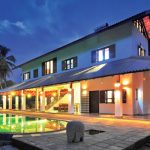-
The CPD lecture
July 2012
The first CPD for the session was held at the HNB towers on 25th May, 2012 on “Designing Environmentally Responsive Buildings”. The objective of the session was to explore some facets of the looming environment crisis, towards which energy guzzling buildings make a fair contribution, to generate a dialog among members of the SLIA on designing environmentally buildings. The speakers were Archt. Raefer Wallis, Mr. David O’Rorke and Archt. Dr. Upendra Rajapaksha. Raefer Wallis is an internationally acclaimed Architect and green building pioneer based in Shanghai. He is pioneering modern rammed earth techniques in China and Sri Lanka. He spoke about his experiences with all of these ventures, focusing particularly on some of the flagship buildings that he has designed. He and his colleague David O’Rorke spoke about GIGA, the first online database in Asia to help designers, developers and builders find the best materials available on the market… freely. Moreover, it has been designed to guide manufacturers towards producing materials that are good for the environment. The website also helps designers showcase their achievements and share their ideas via an online platform. Originally started in China, it is now expanding to south-east Asia and Sri Lanka.
Archt. Dr. Upendra Rajapaksha, a Senior Lecturer in Architectural Design and Architectural Science at the Department of Architecture, University of Moratuwa was the final presenter. He earned his doctorate in architecture specializing in sustainable design from the University of Queensland, Australia. He is engaged in research and practice expertise in carbon constrained low energy architecture and environmental sustainability in the built environment and has worked in Japan, Australia andSri Lanka. He is a Co-designer (with Prof. Richard Hyde) of Gold Coast’s Healthy Home Project which has received the Environmental Award of Queensland Government in Australia. Dr. Rajapaksha spoke on energy sustainability of buildings where he focused on Mapping Architecture for Carbon Neutrality in Building Operation. He drew attention to designing building microclimate, manipulating the building form, the building envelope and integrating mechanical systems for minimizing the need for energy by buildings. He stressed that introducing mechanical systems without making the architectural design energy efficient would not make a building environmentally responsive or sustainable in respect to energy.














